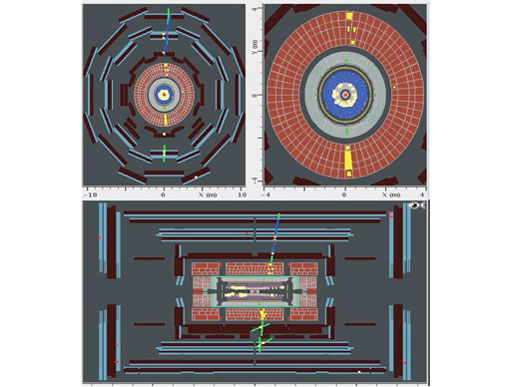
ATLAS e-News
23 February 2011
L1 Calorimeter Trigger
18 November 2008

Cosmic event triggered by L1Calo
Even if calorimeters are designed to detect highly energetic showering particles like electrons, photons and hadrons, the imprints left by cosmic muons can also be very useful for the Level-1 Calorimeter (L1Calo) Trigger system team. Steve Hillier, the team leader, has explained to ATLAS e-news the latest developments.
The L1Calo trigger is in charge of processing the calorimeter trigger sums and forming multiplicities of trigger objects on which the final Level-1 trigger decision is made. The system has been in operation since 2007: “We’ve been tuning it using cosmic data; it has been very useful for us in debugging the detector,” Steve explains.
ATLAS calorimeters are not designed to produce large signals with cosmic muons; while the electromagnetic system has been optimised for electrons and photons, the hadronic calorimeter produce large signals when hadrons hit it. “We are supposed to trigger on those particles,” Steve says. “In general, muons do not produce the sort of energies that we usually expect to trigger on.”
Normally, since muons are minimum ionising particles, they leave less than 2 GeV in deposited energy. “For the calorimeters, these energies are very low, in the noise level range,” Steve explains.
“But occasionally, a muon, will either shower somewhere in the detector, or will take a particular unusual trajectory in the calorimeter, depositing enough energy so that we can see it, [when it is] around 4-5 GeV,” he adds.
These sorts of events have been very useful for those working on the L1Calo trigger: “We could feed them through our system, checking the correctness of the trigger processing logic, and then compare the energies with those seen by the calorimeters,” explains Steve.
However, the whole efficiency in collecting muon events is low and the calorimeters only register about 3Hz of useful data, but still, this small piece of information can be used to debug the detector.
“We can grasp a better understanding of what is happening in the low energy regime,” explains Steve. “[From the] LHC beam, most particles we’ll be looking for, such as isolated electrons, will be in the range of 10 GeV and above, rising with luminosity,” he adds.
So, when the LHC will resume operation, the system will not be generating a large amount of background, thanks to the tuning at low energies. “At the later stage, when we see data from collisions, we will be able to select high energy objects very efficiently,” Steve explains. “Most of what we will keep will be real high energy events from LHC collisions.”
All in all, cosmics runs have been a way to test that the L1Calo trigger works the way it is meant to work. “Now we’ve got a system that operates very well. All of the major problems have been debugged and fixed in the system at Point 1.”
During the shut-down period, the team is working on these other minor problems that still need to be fixed. “We have 7,000 input channels to trigger on, 1% of them have problems of various sorts that need polishing.”
However, Steve is satisfied: “The extra-time has been very useful, by the time September came we were ready for beam, and now we are even more ready for beam,” he laughs.

Cristina JimenezATLAS e-News |